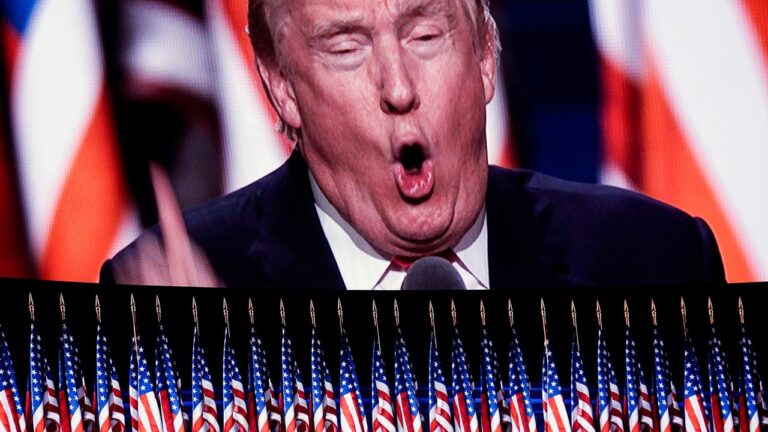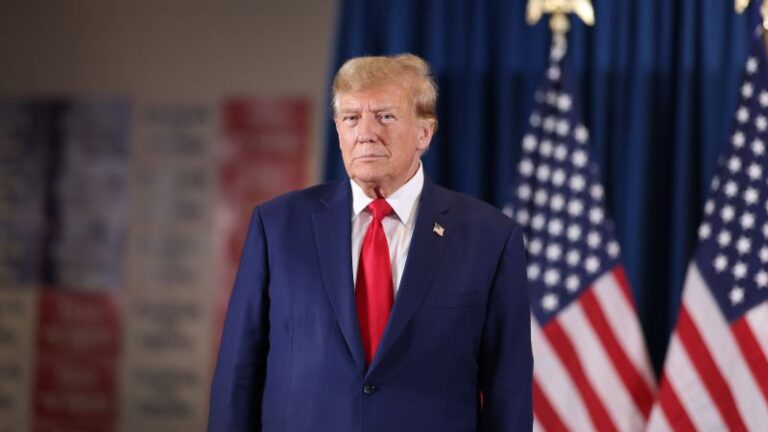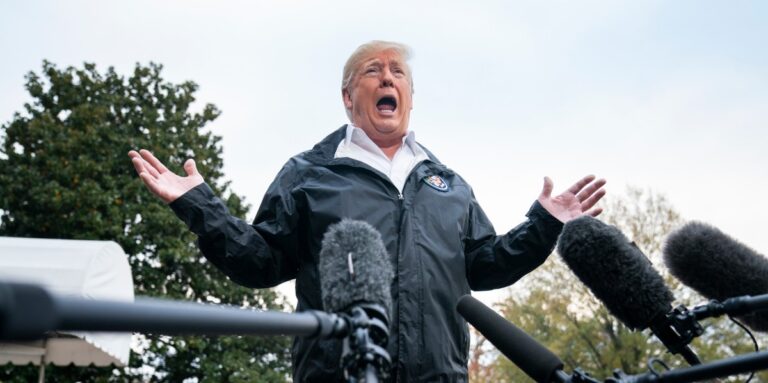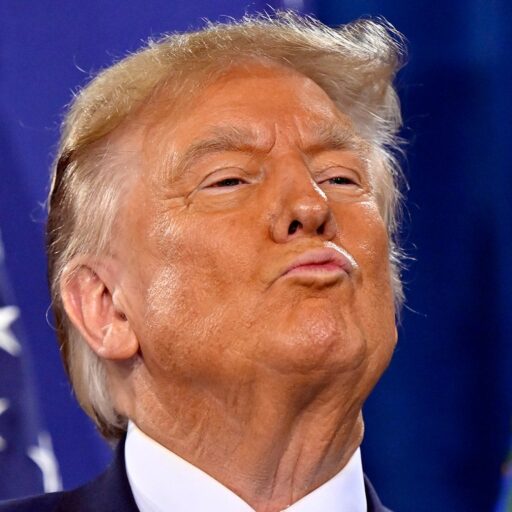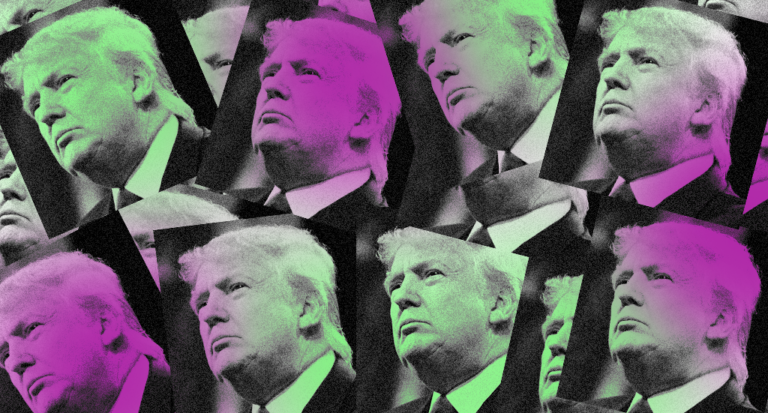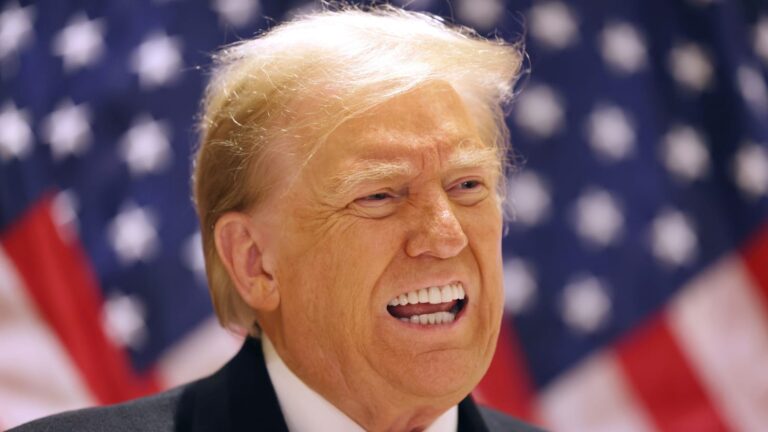PolitiFact has hit a milestone: We published our 1,000th rated fact-check of Donald Trump.
In classic Trump fashion, he claimed in his New Hampshire primary victory speech Jan. 23 that Democrats used the COVID-19 pandemic to “cheat” in the 2020 presidential election.
Unsurprisingly to our regular readers, his claim was Pants on Fire.
It’s not unusual for politicians of both parties to mislead, exaggerate or make stuff up. But American fact-checkers have never encountered a politician who shares Trump’s disregard for factual accuracy.
Our fact-checking saga of Trump began in 2011, when he used his celebrity to amplify “birther” conspiracy theories to undermine former President Barack Obama’s eligibility. The pace of our checks intensified in 2015, with his surprise Republican primary ascent and his 2016 defeat of Hillary Clinton. Trump’s turbulent policy-by-Twitter updates kept our reporters sprinting during his presidential tenure. He downplayed the COVID-19 public health threat and fanned persistent falsehoods about voting and election results that culminated in the Jan. 6, 2021, attack on the U.S. Capitol.
Trump’s fast-and-loose style surely endears him to some of his supporters, who propelled him to the White House in 2016 and made him the Republican front-runner to challenge President Joe Biden in 2024.
The 45th president stands apart — and the election year has barely started. Here’s what our fact-checking data shows us about his Truth-O-Meter record so far.
It will be some time before another politician hits 1,000 ratings. After Trump, our three most-fact-checked politicians are all Democrats: former President Barack Obama with 603 fact-checks, 2016 Democratic presidential nominee Hillary Clinton with 301, and President Joe Biden with 286.
Trump stands alone for the share of rated claims that are some degree of false. About 76% of his statements earned ratings of Mostly False, False or Pants on Fire. The median rating for his 1,000 checks is False.
More than 18% of our fact-checks of Trump landed at Pants on Fire, which we define as a statement that is not just false but ridiculous.
About a quarter of Trump’s 1,000 rated statements landed on the relatively true side of our meter (True, Mostly True or Half True). Often these involved statistics, such as his accurate tweet in 2019 that said U.S. food stamp program participation had hit a 10-year low.
Trump’s median rating of False is worse than a cross-section of frequently checked Democratic and Republican politicians. Politicians with median ratings of Half True include Obama, Biden and Hillary Clinton; three senators who ran for president, Mitt Romney, R-Utah, Marco Rubio, R-Fla., and Bernie Sanders, I-Vt.; and two longtime congressional leaders, Sen. Mitch McConnell, R-Ky., and former House Speaker Nancy Pelosi, D-Calif.
Trump has also fared worse than three frequently checked politicians who have a median rating of Mostly False: Sen. Ted Cruz, R-Texas; former House Speaker Newt Gingrich, R-Ga.; and Sen. Ron Johnson, R-Wis.
“It’s been an astounding eight years in American politics,” said Jennifer Mercieca, a Texas A&M University communication professor and a historian of American political rhetoric. “He’s built his entire political identity on the fact that he doesn’t owe anyone the truth about anything.”
A relentless flow of ‘truthful hyperbole’
In his 1987 best-seller “The Art of the Deal,” Trump described “why a little hyperbole never hurts.”
“People want to believe that something is the biggest and the greatest and the most spectacular. I call it truthful hyperbole,” Trump wrote. “It’s an innocent form of exaggeration — and a very effective form of promotion.”
That approach held true for politics as it did for business. Ever since he descended the escalator at Trump Tower in 2015, we have encountered a firehose of claims.
He talks a lot — in TV interviews, on social media, at campaign rallies that stretch for nearly two hours. As president, Trump made Twitter essential reading, before the social media platform exiled him after the Capitol riot. Of the tweets we checked, about 79% rated Mostly False or lower. So far, on his Truth Social platform, we have not yet rated a claim higher than Mostly False.
Among his most common settings for claims, Trump fared best in State of the Union addresses. His median Truth-O-Meter rating for those annual speeches inched into the Half True range.
In practice, we have looked at many more Trump statements than just the 1,000 cited in this article.
Each of the 1,000 fact-checks has a formal Truth-O-Meter rating. Sometimes, we instead write articles about claims without rating them. Examples include summaries of multiple claims made in a debate, rally or major speech. Other times, a statement is a prediction, or too vague for us to rate, or involves an unanswerable question, such as how courts will rule in the classified documents case. In those cases, we’ll write an explanatory story without a rating. These are not captured in Trump’s Truth-O-Meter scorecard.
The Washington Post’s Fact Checker column sought to collect every statement by Trump during his term that Glenn Kessler and his team determined was false or misleading. They ended up with 30,573 statements.
Even though these mentions were usually brief rather than fully detailed fact-check articles, and even though they included many repeated claims, compiling the database was “exhausting,” Kessler told us. The database ended up at about 5 million words.
After this experience, Kessler said the Post has capped future efforts at the first 100 days of a new presidency, as the newspaper did for Biden’s 78 false or misleading claims.
If the past is prologue, 2024 will be another peak year for checking Trump. Our rated fact-checks peaked in 2016 and 2020, the two years he ran for president.
In the beginning, there was birtherism
For Trump’s accusations and insults, accuracy hardly matters.
In 2011, Trump leveraged his TV businessman persona to discredit Obama’s legitimacy as the nation’s elected leader. Trump told an annual conservative conference that the people who went to school with Obama “never saw him, they don’t know who he is.” His accusation was part of “birtherism,” a series of false beliefs that Obama, the first Black president and one with Kenyan lineage, wasn’t a natural-born American citizen. We rated this statement Pants on Fire!
He kept repeating birther claims through his 2015 campaign. In 2016, Trump falsely said Clinton started the rumors about Obama’s birthplace. Clinton supporters circulated the rumor in the 2008 Democratic primary’s final days and after Clinton had conceded to Obama. But the record did not show Clinton or her campaign ever promoting, or starting the birther theory.
In his new campaign, Trump promoted baseless birtherism claims about Republican rival Nikki Haley, a former United Nations ambassador and South Carolina governor who was born on U.S. soil to immigrant parents.
Sometimes it’s easy to fact-check Trump because his statements fly in the face of available video. He tweeted in 2020 that “I never called John (McCain) a loser.” But 2015 video of Trump speaking in Ames, Iowa, showed that he said of McCain, “I never liked him much after” McCain lost the 2008 presidential race, “because I don’t like losers.”
During a 2016 GOP primary debate, Trump said of former Florida Gov. Jeb Bush, that “he said he would take his pants off and moon everybody … nobody reports that.” Bush was making a joke about what he felt was scant press coverage. We rated Trump’s statement Mostly False.
We have fact-checked many politicians who admit, usually through a spokesperson, that they misspoke. When Trump is challenged on his dubious statements, he typically ignores reporters’ questions or says he shouldn’t have to defend his words.
In November 2015, Trump tweeted an image that crime statistics show Black people kill 81% of white homicide victims. We rated the statistic Pants on Fire. Days later, then-Fox News host Bill O’Reilly told Trump he was wrong.
“Hey, Bill, Bill, am I gonna check every statistic?” Trump said. “I get millions and millions of people.”
Trump is the three-time winner of our annual Lie of the Year, which we award for the year’s most significant falsehood. He won:
-
In 2015 for three outrageous claims in the Republican presidential primary, including the claim about Black people.
-
In 2017 for calling claims of Russian election interference a “made-up story.”
-
In 2019 for saying a whistleblower got his call with Ukraine’s president “almost completely wrong” when the account was close to the White House’s own transcript.
Trump shared in our 2020 and 2021 Lies of the Year for his efforts to downplay the threat of COVID-19 and the significance of the Jan. 6 Capitol attack, respectively.
By topic, Trump’s immigration claims stand out
PolitiFact’s focus has been on Trump’s more consequential statements. His rhetoric around immigration often distorts reality.
Trump campaigned in 2015 and 2016 on a message of fear of immigrants illegally in the U.S. He told Americans that “the Mexican government … they send the bad ones over.” That’s Pants on Fire. Most Mexicans were crossing the border seeking work. There was no evidence that their government sent criminals.
Trump also wildly misrepresented Democratic policies. In October 2016, he said Clinton would allow 650 million immigrants into the U.S. in one week. That’s an absurd number considering the U.S. population was about half that amount.
In December 2017, Trump said that under the diversity visa lottery program, other countries “give us their worst people” — a distortion of how the U.S. government vets and selects them.
During the 2020 campaign and Biden’s presidency, Trump continued to use scare tactics, falsely stating that Biden halted virtually all deportations, including of murderers, or planned to give immigrants welfare benefits.
Trump’s falsehoods have fueled threats to democracy
Trump’s ridiculous statements about elections stretch back to 2016, when a few months before Election Day he called elections “rigged.” After he won in 2016, Trump claimed there was “serious voter fraud” in states he lost. It was particularly absurd for him to blame voter fraud for his 2016 loss of California, a state that hadn’t voted for a Republican for president since George H.W. Bush in 1988.
Trump’s election falsehoods increasingly became focused on grievances.
As Trump faced reelection in 2020, he said Biden could win only if the election was rigged. Elections are administered in thousands of local areas nationwide, each with safeguards, making any attempt to “rig” a national election highly improbable.
Trump’s election result denial has poisoned many Americans’ views on voting, misleading the public about how elections are run.
A December 2023 Washington Post/University of Maryland survey found that about one third of respondents believed there was solid evidence of widespread voter fraud in 2020.
Gallup found before the 2022 midterms that most Americans were very confident or somewhat confident that the results would be accurately counted. Democrats were more than twice as confident as Republicans, representing the largest gap Gallup has recorded on this measure since 2004.
One week before the 2020 election, Trump said counting ballots for weeks after Election Day “is totally inappropriate, and I don’t believe that’s by our laws.” However, most ballots are counted quickly; federal law allows states more than a month after the election to check their math, resolve disputes.
In the early morning hours after polls closed, Trump made the ridiculously premature declaration that he had won. Because the ballots were still being counted, no one could say with any confidence whether Trump or Biden had won. Yet claims that Trump had won prompted Trump’s supporters — some armed — to gather outside of vote counting sites including in Philadelphia and Arizona’s Maricopa County, home to Phoenix.
Trump continued this theme over the next several weeks, telling his supporters of “surprise ballot dumps” and “massive fraud” that did not exist. He told his allies, “Statistically impossible to have lost the 2020 Election. Big protest in D.C. on January 6th. Be there, will be wild!”
More than 1,200 people have been charged in the attack on the U.S. Capitol. Court records show that some have said Trump told them to act. Whether Trump faces consequences for actions to subvert lawful election results remains to be seen in Fulton County, Georgia, and the federal courts.
What is PolitiFact’s role?
Readers sometimes ask us what our endgame is with a politician like Trump. They say our fact-checks don’t keep Trump from repeating his false claims, including lies about the 2020 election.
It’s not our job to silence Trump or force him to change his rhetoric. Nor is it our job to tell voters how they should mark their ballots.
Our job is to provide factually vetted information to voters so they can make informed choices.
We fact-check all major political parties, holding their leaders and candidates accountable for misleading rhetoric. We write for Americans who are open to considering evidence. And we document for the historical record, including analysts who will study the Trump era for decades to come.
RELATED: These are PolitiFact’s top 10 most-read fact-checks of Donald Trump
RELATED: How Trump fared on 100 campaign promises tracked on our Trump-O-Meter
RELATED: The Principles of the Truth-O-Meter: PolitiFact’s methodology for independent fact-checking

